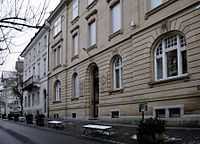Fabergé Museum
| Fabergé Museum | |
|---|---|
|
Street view | |
 Fabergé Museum | |
| Established | 2009 |
| Location | Baden-Baden |
| Coordinates | 48°45′43″N 8°14′35″E / 48.762°N 8.243°E |
| Collection size | 3,000 |
| Website | Fabergé Museum website (in German) |
The Fabergé Museum is a museum located in the German spa city of Baden-Baden, dedicated to items made by the Russian jewellery firm Fabergé. It was opened in 9 May 2009[1] by Russian art collector Alexander Ivanov.
Description
The museum's collection numbers almost 700 items made by Fabergé. The most significant item in the museum's collection is the Rothschild Fabergé egg, that was made as an engagement gift from Béatrice Ephrussi de Rothschild to her brother's fiancée. Ivanov bought it at the auction house Christie's in London on 28 November 2007, for £9 million[2] because he thinks that it’s the “finest ever” made by Fabergé.
Besides the Rothschild Fabergé Egg, other items in the museum collection include a rare silver decanter in the form of a rabbit, and the last Fabergé Egg, the Karelian Birch egg made of Karelian birch with gold and diamonds for Easter 1917. Czar Nicholas II, however, was deposed before he could give it to his mother. When Ivanov first bought the Karelian egg, some experts resisted because its existence wasn’t known previously. Ivanov now has documents found in the Russian state archives proving the egg is genuine.[3]
The Fabergé company was founded in St. Petersburg in 1842, and it was an official supplier to the Russian Imperial court from 1885 to 1917. It also supplied high-end luxury goods to the Russian and European aristocracy. Besides the czars, clients include the Queen of the United Kingdom, and the royal family of Siam (now Thailand). Fabergé was closed after the Bolsheviks seized power in 1917, and its exquisite items were almost forgotten and no longer cherished. The company’s artworks became popular again in the 1960s with Western collectors, led by Malcolm Forbes. Prices rose to records in the early part of the 21st century thanks to Russians such as Ivanov who took a fancy to fine artworks that comprise their country’s heritage.
Ivanov said his museum building cost about 17 million euros to buy and renovate, including a 1 million euro security system. He chose Baden-Baden, near Germany’s western border, because it is “quiet and nice, middle in Europe, close to France and Switzerland, a resort for the rich, and historically it has always been the most popular resort for Russians.”[3]
Ivanov said that one reason that he opened the museum in Germany was due to safety concerns. He told Britain's Independent newspaper: "It's very difficult [in Russia] because of all the administrative barriers [...] You have to be indebted to someone, and you can never feel that your collection is safe – not from the state, not from bandits, not from anyone. In Germany we spend serious money on security of course, but at least you know that the state itself won't do anything."[2]
The museum's first year was marked by a bitter court conflict. In April 2009, just a month before the official opening, a company calling itself Faberge Ltd. that is registered in the Cayman Islands-based company owned by the Gilbertson family of South Africa, filed a lawsuit over rights to the Fabergé trademark. This made the Fabergé museum’s first year a difficult one. While the case was pending, the museum couldn’t use the Fabergé name, which meant no advertising or even a sign on the door. In January 2010, a German court ruled in favor of the Fabergé Museum, and it immediately began to resume functioning with full right to use the Fabergé name.[4]
In May 2012, the Fabergé Museum opened a new permanent exhibition titled Gold of the World. It consists of just over 100 gold items from various civilizations and continents that date from the 6th century B.C. up until the mid 20th century. Among the items are an ancient Iranian chalice, ancient Greek jewelry, Fabergé cigarette cases, Aztec and Inca gold jewelry, and a very rare 18th century British gold trophy.[5]
References
- ↑ "Открытие Музея Фаберже". Retrieved 21 December 2010.
- ↑ 2.0 2.1 Russian billionaire feathers his Fabergé nest egg, Independent
- ↑ 3.0 3.1 "Tycoon Ivanov Reveals $1.5 Billion Faberge Surprise for Germany". Bloomberg.
- ↑ Ivanov Vies Faberge, Boosts $2 Billion Museum Collection, Bloomberg
- ↑ "Fabergé Museum opens a new permanent exhibition dedicated to gold jewelry over the past 2,500 years", Art Daily
External links
- Fabergé Museum website (in German)
